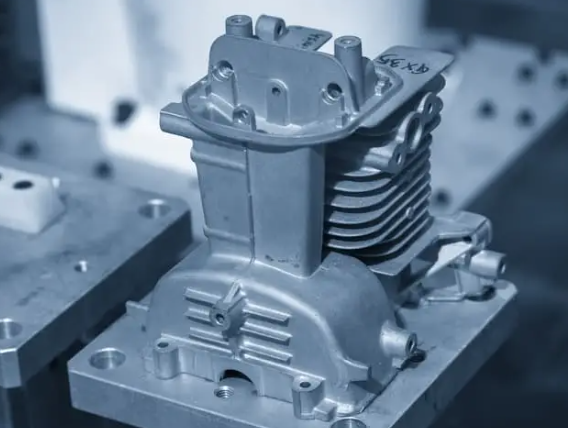Low-pressure die casting is a subset of die casting, a metal casting process used to create metal components with complex geometries and excellent mechanical properties. It is also known for its precision.
This guide will discuss the fundamentals of low-pressure die casting and how it minimizes defects and improves consistency in metal manufacturing for people new to the technique.
What is Low Pressure Die Casting, and How Does it Work?
Low-pressure die casting, or LPDC, is a metal die casting process used in metal part manufacturing to cast precision metal components. From its name, its mechanism is based on low pressure, which is responsible for its ability to create parts with intricate designs, superior mechanical properties, and smooth surface finishes.
How Does Low Pressure Die Casting Work?
LPDC is similar to high-pressure die casting (HPDC) in terms of setup but is for materials with high melting points, such as aluminum and magnesium. The mold, often a reusable steel mold, is prepared by coated with a release agent and preheated to ensure proper metal flow.
Because of its high melting, the metal to be cast is melted in a furnace and transported to a holding chamber. Afterwards, it is forced into the mold cavity at low pressure (usually 0.1–1.5 bar).
The metal cools within the mold, taking its final shape, with cooling channels or natural conduction accelerating this process. After solidification, the mold is opened, and the part is ejected for further processing, like trimming or machining.
Key Characteristics of Low Pressure Die Casting
The low-pressure die-casting process is unique because of several characteristics that support its ability to create such quality parts. One major characteristic is its precise filling, enabled by injection at low pressure.
The low-pressure system ensures controlled filling and lower turbulence. As a result, similar to gravity casting, low-pressure cast components have better surface finishes than the other metal casting techniques.
Another key characteristic is the mold’s durability. Using reusable steel molds enhances cost-efficiency over time. Finally, its low pressure system also leads to higher dimensional accuracy, especially for parts that require tight tolerances and smooth finishes.
Advantages of Low Pressure Die Casting
Low-pressure die casting has several advantages over high pressure die casting and other metal casting techniques. They include:
Superior Quality Parts
The process minimizes porosity, producing components with excellent mechanical strength. This makes LPDC the best option to die cast engine blocks and aerospace components.
Consistency and Repeatable
Low pressure ensures uniform metal flow, reducing defects and achieving consistent quality across multiple production runs.
Complex Geometry Capabilities
LPDC enables the production of parts with intricate designs, thin walls, and tight tolerances thanks to its precise mold-filling technique.
Material Efficiency
The process minimizes waste as unused metal can be recycled, lowering material costs and promoting sustainability.
Cost Efficiency for High Volumes
While initial tooling costs are high, mold reusability and automation capabilities make LPDC cost-effective for large-scale production.
Disadvantages of Low-Pressure Die Casting
Low-pressure die casting also has a few disadvantages, which include:
High Initial Setup Costs
The need for durable molds and specialized equipment demands significant upfront investment, which may not be suitable for small-scale operations.
Limited Material Range:
LPDC is primarily used with non-ferrous metals like aluminum and magnesium. It is less suitable for ferrous alloys or materials requiring extremely high melting points.
Slower Cycle Times
Compared to high-pressure die casting, LPDC has longer cycle times due to the slower mold-filling process and cooling period.
Design Constraint
While capable of intricate geometries, LPDC struggles with parts requiring extremely fine features or rapid transitions between thin and thick sections.
Applications of Low Pressure Die Casting
Low-pressure die casting is widely adopted in industries requiring durable, lightweight, and precise components. Below are key applications:
Automotive Industry
The automotive industry uses low-pressure die casting in fabricating engine components like cylinder heads, engine blocks, and oil pans. Furthermore, the process can make structural parts like chassis components and cross-beams
Aerospace Industry
The aeroplane industry uses it to make lightweight yet robust aircraft parts, such as turbine housings and airframes. It also makes heat-resistant alloy components for parts exposed to high temperatures and stress.
Electronics Industry
LDPC is used to make aluminum and magnesium casings for electronics, which offer durability and electromagnetic interference (EMI) shielding.
Industrial Equipment
High-quality, corrosion-resistant pumps, valves, and lightweight machine frames are made using low pressure die casting. The casting process is also suitable for making wind turbine components and structural solar energy system components like brackets and frames.
Medical Devices
Low-pressure die casting is applicable in making lightweight housings for imaging and monitoring equipment and aluminum-based surgical tool components
Conclusion
Low-pressure die casting is a versatile and reliable manufacturing process for producing high-quality, durable components with complex geometries. Its advantages, such as superior strength, material efficiency, and cost-effectiveness for high-volume production, make it an invaluable tool in the automotive, aerospace, and electronics industries.
However, LPDC also has limitations, including high initial costs and longer cycle times, which must be considered when selecting the most suitable manufacturing method. For applications requiring precision, strength, and lightweight properties, LPDC remains an excellent choice that effectively balances quality and efficiency.

